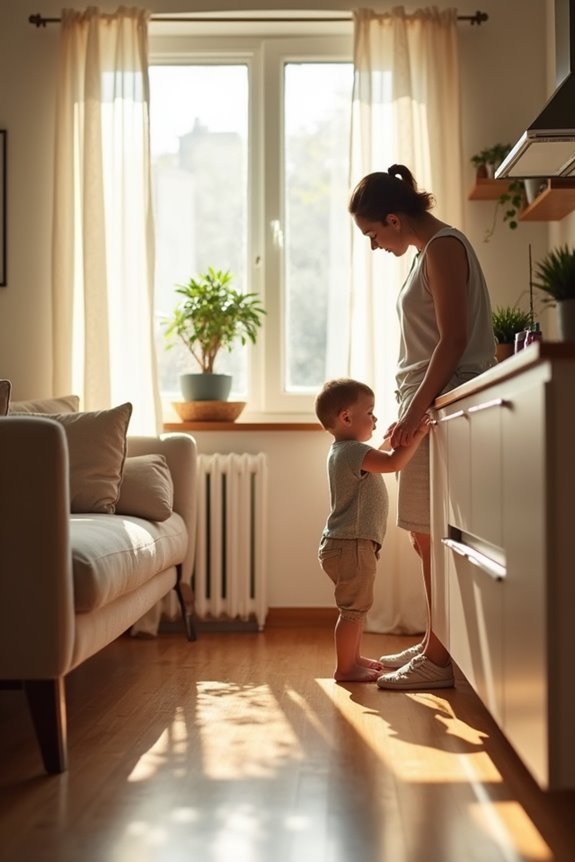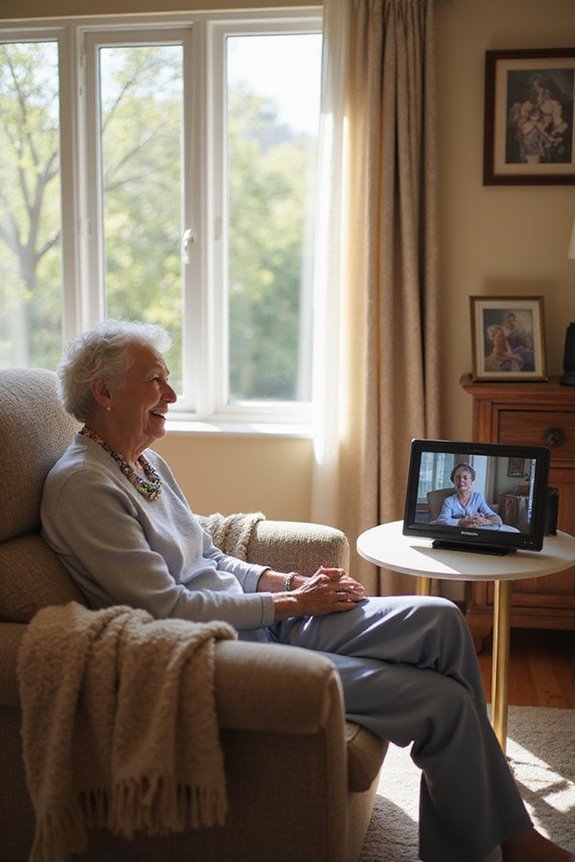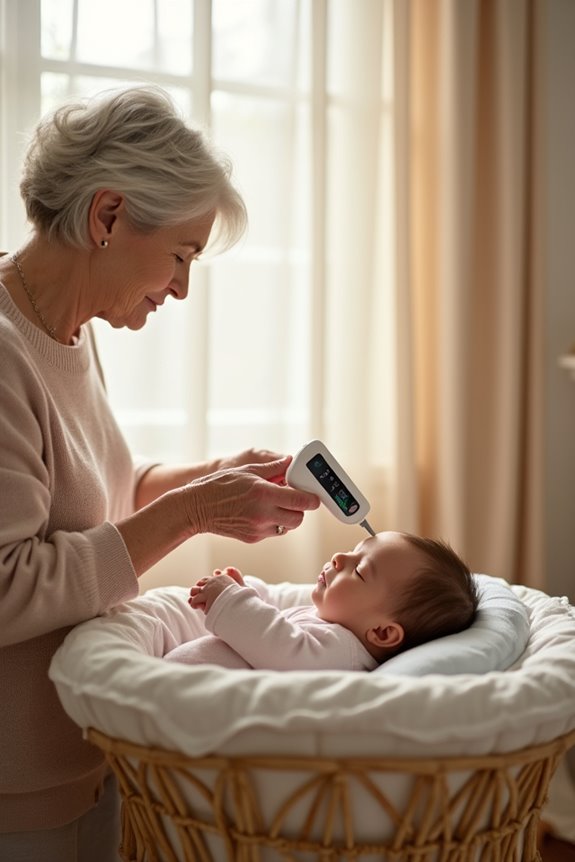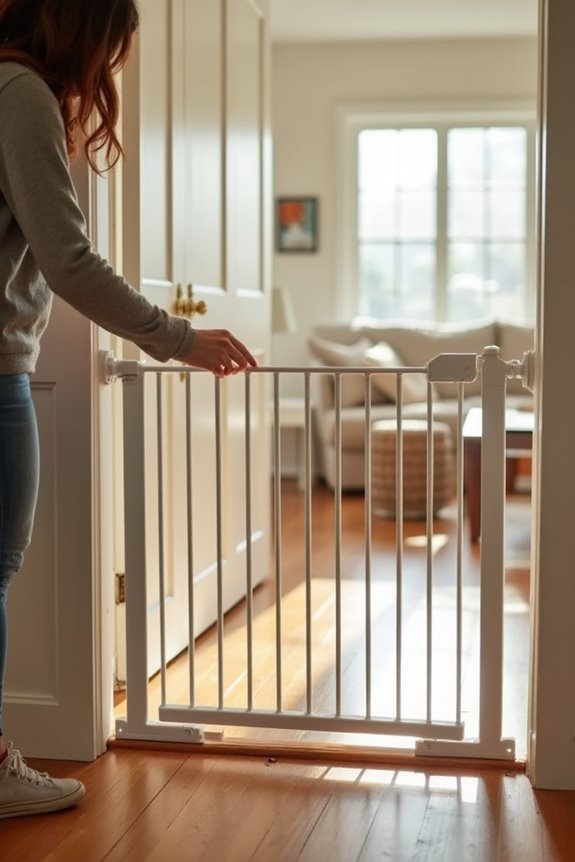To choose the right baby-proofing products, evaluate potential home hazards. Prioritize purchasing JPMA-certified baby gates and hardware-mounted options for security. Secure furniture with L brackets and anchor devices to prevent tip-overs, as nearly 200,000 children under five are injured annually from such incidents. Install Tamper Resistant Receptacles (TRRs) to enhance outlet safety and manage cords to reduce tripping risks. Research product quality, certifications, and reviews to guarantee reliability. Further details can enhance informed decisions.
Key Takeaways
- Look for baby proofing products with JPMA certification and ASTM compliance to ensure safety standards are met.
- Choose materials that are durable and safe, such as BPA-free plastics for outlet covers and metal for baby gates.
- Prioritize products that minimize entrapment risks, like gates with appropriate spacing and secure installation methods.
- Regularly check product reviews and safety recall histories to assess reliability and performance from verified users.
- Implement childproof designs like tamper-resistant outlets and cord management solutions to reduce potential hazards around the home.
Identifying Potential Home Hazards
Identifying potential home hazards is a critical step in creating a safe environment for infants and toddlers. Effective hazard identification involves evaluating various rooms and common household features.
Common Hazards:
- Living Room: Furniture and electrical appliances pose risks for injuries.
- Kitchen: Sharp implements and heated appliances are prevalent dangers.
- Bathroom: Prescription medications and cleaning agents can lead to poisoning.
- Outdoor Areas: Pools and playground equipment present considerable injury risks.
Conducting a thorough safety evaluation is essential. This includes checking furniture stability, identifying choking hazards, and ensuring proper safety measures like child-resistant lids for hazardous substances. Awareness of these potential dangers can greatly lower injury rates, promoting a secure living space for young children. Additionally, using child-proof electrical protectors can help safeguard against electrical hazards in your home.
Choosing the Right Baby Gates
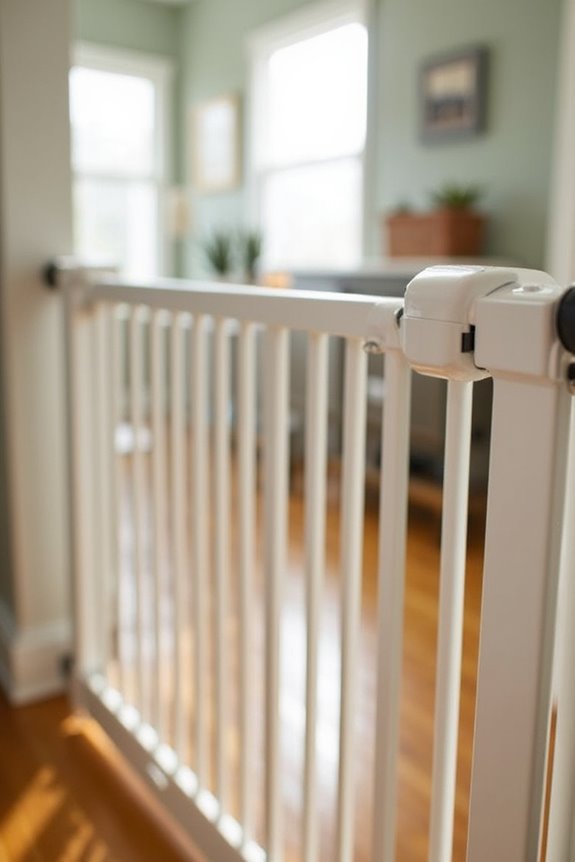
When selecting baby gates, what factors should be considered to guarantee safety and functionality?
Safety Standards
- Certifications: Choose gates with JPMA certification and ASTM compliance to verify safety.
- Hazard Elimination: Look for gates that minimize risks of entrapment and have safe spacing.
Gate Types and Materials
- Types: Hardware-mounted gates offer maximum security; pressure-mounted gates are suitable for low-risk areas.
- Materials: Options include metal for durability, wood for a smooth finish, and fine mesh to prevent climbing.
Installation and Fit
- Height Requirements: Minimum height of 22 inches is essential.
- Spacing: Verify less than 3 inches between the gate bottom and floor. Additionally, consider proper installation to avoid gaps that could pose safety risks.
Regular inspections and proper usage are vital for maintaining safety.
Securing Furniture and Appliances
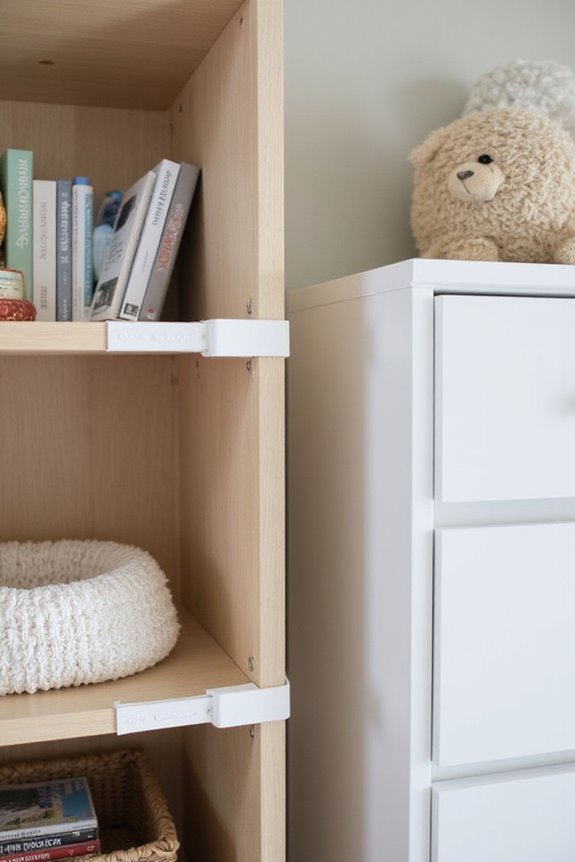
Securing furniture and appliances is an essential aspect of childproofing, as many items in the home pose considerable risks to young children. Tall, top-heavy furniture, such as dressers and bookshelves, can tip over, leading to serious injuries.
Furniture Anchors
- L brackets and furniture anchors are important tools.
- Proper installation of these devices greatly reduces the risk of tip-over incidents.
Appliance Safety
- Appliances like stoves and ovens also present dangers when children climb on them.
- Anti-tip devices for these appliances are crucial to prevent accidents.
Statistics reveal that nearly 200,000 children under five are injured annually by furniture-related incidents. As a result, prioritizing furniture and appliance safety is essential for protecting children in the home. Additionally, implementing childproof designs on outlets can help further minimize electrical hazards in households with young children.
Protecting Electrical Outlets and Cords
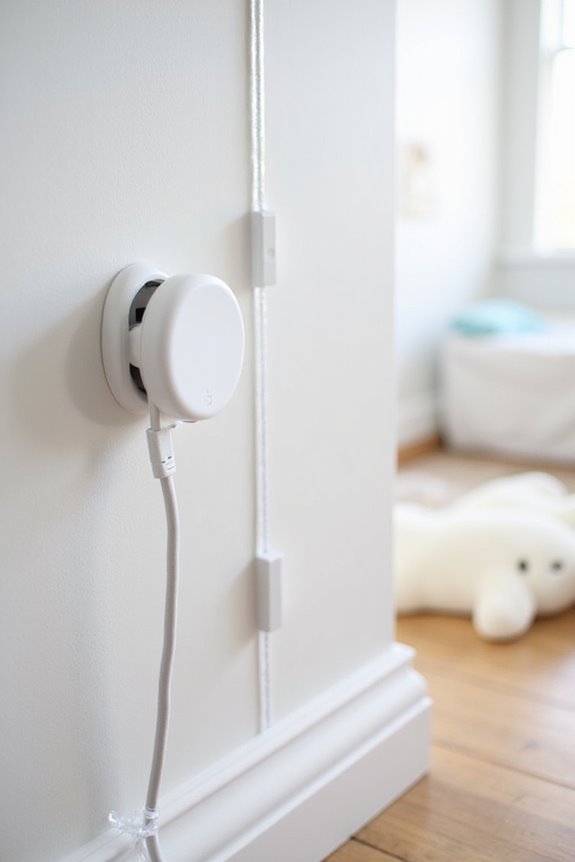
Protecting electrical outlets and cords is fundamental in minimizing risks associated with electrical injuries among young children. Statistics reveal that approximately 2,400 children are treated annually in U.S. emergency rooms for outlet-related injuries, with 89% of them being under six years old. To enhance outlet safety, parents should consider installing Tamper Resistant Receptacles (TRRs), as traditional plastic caps can be easily removed by toddlers. Additionally, using durable, BPA-free materials for outlet covers can ensure long-lasting protection against electrical hazards. Cord management is equally important; exposed cords present risks of tripping and strangulation. Effective solutions include cord shorteners, cable covers, and secure ties to keep cords out of reach. Regular inspections of cords for damage are essential to guarantee ongoing safety. By implementing these measures, parents can create a safer environment for their children.
Enhancing Corner and Edge Safety
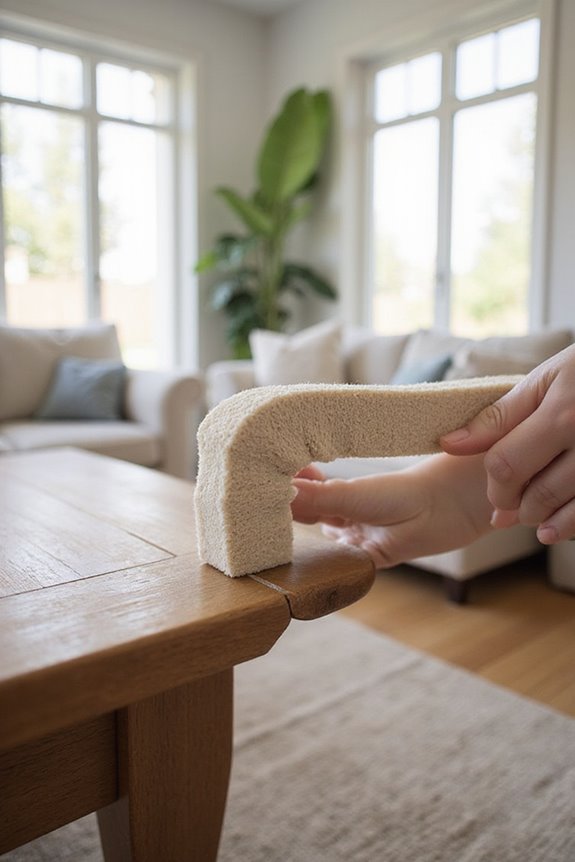
Enhancing corner and edge safety is essential for preventing injuries in homes with young children. Corner guards, made from various corner guard materials such as foam, soft vinyl, and clear plastic, effectively shield sharp furniture edges. These products are available in multiple edge protector styles, including L-shaped and ball-shaped designs, catering to different furniture configurations.
Key considerations include:
- Material Variations: Each type offers unique durability and aesthetic appeal.
- Installation Ease: Options with pre-taped backs simplify setup.
- Color Options: Available in hues like oyster white and coffee brown to match home decor.
- Multipurpose Use: Versatile protectors can also safeguard picture frames and other sharp objects.
Selecting the appropriate product is vital for creating a safe environment for children.
Evaluating Product Quality and Reviews
When considering baby proofing products, how can one ascertain that the selected items meet essential safety standards? Evaluating product quality begins with verifying product certifications. Key certifications include:
- ASTM Standards: Compliance guarantees durability and safe design.
- CPSC Enforcement: Mandatory testing assures adherence to federal safety standards.
- FDA Guidelines: Products must be free from harmful chemicals like BPA.
Additionally, scrutinizing reviews is vital. Independent lab testing results should align with customer feedback. Reliable products often have:
- Consistent positive reviews from verified buyers.
- Certification transparency, displaying safety labels clearly.
Lastly, checking a product’s recall history can reveal its safety reliability. By focusing on these aspects, caregivers can make informed choices, assuring that baby proofing products meet necessary safety standards.
Ensuring Proper Installation and Maintenance
Guaranteeing proper installation and maintenance of baby proofing products is essential for maximizing safety in environments occupied by young children.
Installation Techniques
- Follow manufacturer instructions precisely to assure effectiveness.
- Clean surfaces before applying adhesive products for better adherence.
- Use recommended tools for mounting products securely.
- Position devices out of children’s reach to prevent tampering.
- Utilize the minimal number of screws for stability without structural damage.
Maintenance Practices
- Conduct regular checks to verify all items are securely attached.
- Test functionality of locks and gates frequently.
- Replace or repair any damaged products immediately.
- Clean safety devices periodically to enhance performance.
- Keep spare parts available for quick replacements.
- Ensure that materials quality is high to resist wear and maintain effectiveness over time.
Adhering to these guidelines promotes a safer environment for young children.
Frequently Asked Questions
How Can I Determine the Right Height for Baby Gates?
To determine the right gate height, one must consider safety standards, which recommend a minimum of 30 inches. This height helps prevent climbing while ensuring children remain safe in their environment, fostering a secure atmosphere.
Are There Baby Proofing Products for Pets Too?
Various baby proofing products cater to pet safety, offering dual protection for households with both babies and pets. Solutions like specialized gates and secure feeding areas foster a harmonious environment, ensuring safety for everyone involved.
What Should I Do if My Child Removes Safety Devices?
Like a persistent gardener tending to a stubborn weed, caregivers should implement alternative safety measures and child behavior strategies. Reinforcing boundaries, using engaging distractions, and modeling safety can help children understand the importance of safety devices.
How Often Should I Inspect Baby Proofing Products?
Regular safety inspections of baby proofing products should occur monthly, focusing on product lifespan and functionality. Increased scrutiny is essential during developmental milestones, ensuring a secure environment that fosters a sense of belonging and safety for children.
Can I Use DIY Solutions for Baby Proofing?
In the domain of nurturing, DIY safety acts as a protective shield, akin to a parent’s embrace. Home remedies, like outlet covers and soft corner cushions, offer budget-friendly solutions, fostering a secure environment for little explorers.

